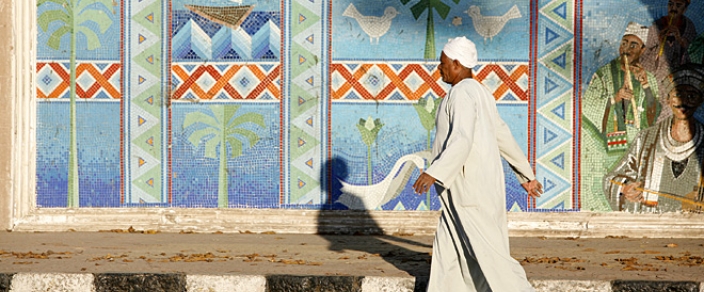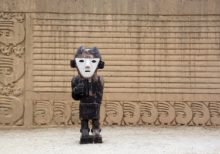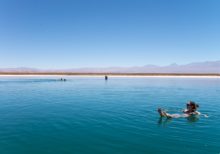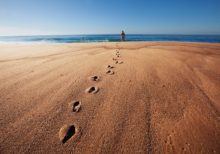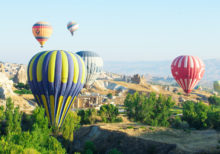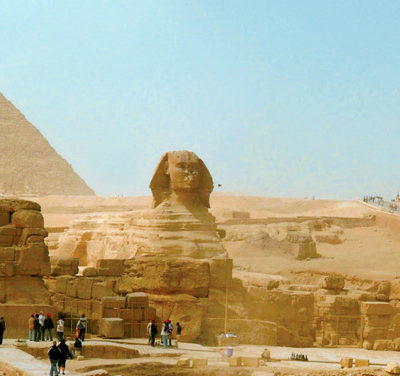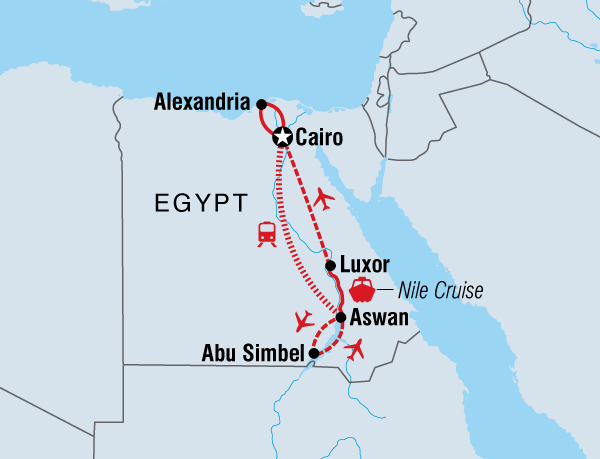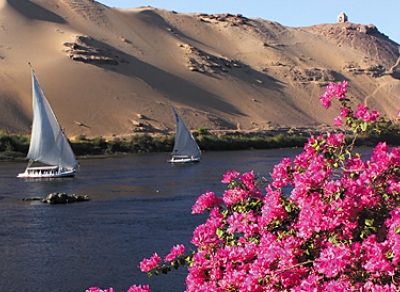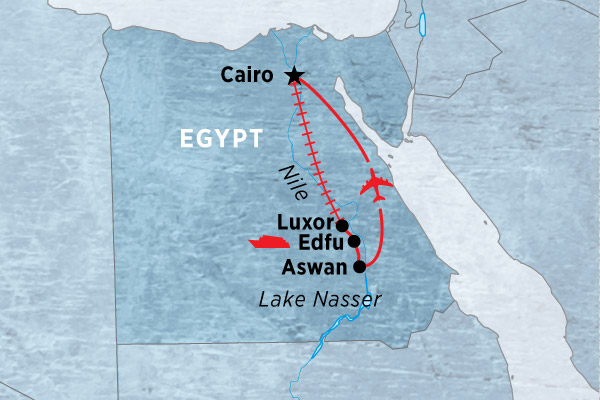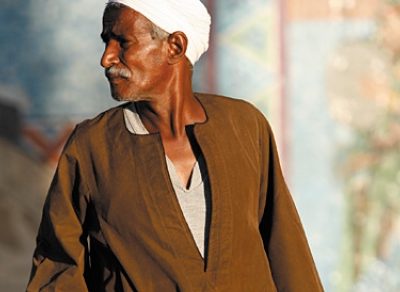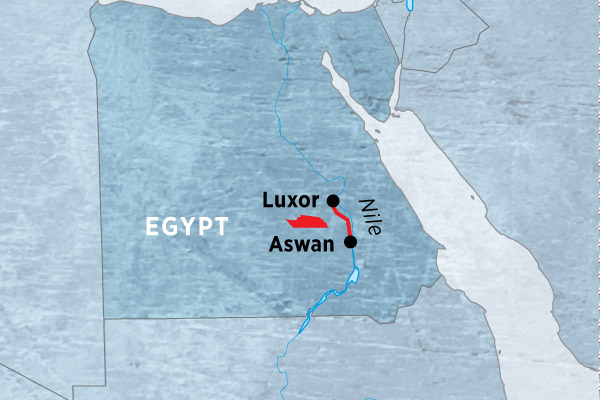| Starts | Cairo, Egypt |
|---|---|
| Ends | Tel Aviv, Tel Aviv, Israel, Israel |
| Region | Middle East & North Africa |
| Duration | 23 days |
| Tour Operator | Peregrine |
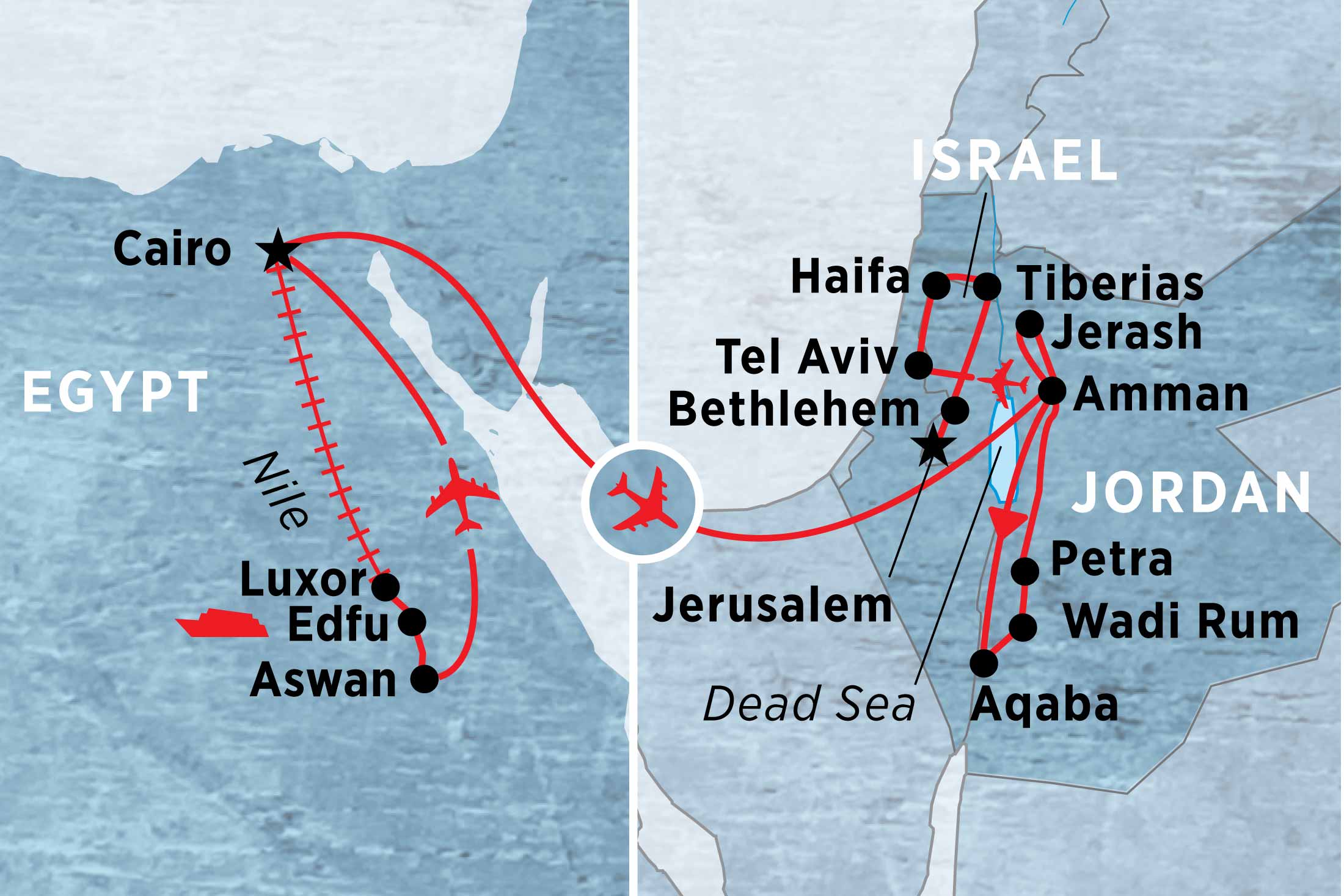
Itinerary
Day 1 - Starting: Cairo & Finishing: Cairo
Arrive at Cairo International Airport and be transferred to your hotel. This is simply an arrival day, so you may arrive in Cairo at any time. Note that hotel rooms are generally only available after midday. The remainder of the day is free to explore the city, but an important welcome meeting will be held in the evening. Check the hotel reception for details. Cairo is one of the great cities of antiquity and its history can perhaps be symbolised by two imposing landmarks - the Pyramids of Giza and the Mosque of Mohammed Ali. In free time perhaps get out and explore the busy streets of this city of contrasts, where you can see donkey carts and expensive cars, medieval slums and modern shopping malls.
Day 2 - Starting: Cairo – overnight train & Finishing: Cairo – overnight train
After breakfast, visit the Egyptian Museum, home to one of the world's great collections of antiquities; it exhibits many of the region's treasures and is the perfect introduction to your tour. Your expert guide will take you through Egypt's rich and fascinating dynastic history. Afterwards you'll have some free time to explore on your own. You may wish to visit the Royal Mummy Room, home to some of the country most important queens and pharaohs from 1650 to 945 BC (this is optional and at extra cost). Your next stop is Giza, home to perhaps the greatest iconic structures ever created by man – the Pyramids and the Sphinx. Instantly familiar yet retaining a mystique and power, these pharaonic tombs are incredible to see up close. There's the option of going inside the Great Pyramid of Khufu (or Cheops), although occasionally it may be closed to visitors. Return to your hotel, freshen up, pack your things and transfer to the station for your overnight train to Luxor (approximately 10 hours). Notes: Sleeping berths (beds and linen) are provided in private cabins and an airline-style dinner will be served. It is worth bringing additional snacks; your tour leader can help you arrange this. Facilities are located at the end of each carriage.
Day 3 - Starting: Luxor & Finishing: Luxor
After an early breakfast on board, the train rolls into Luxor. It's a vibrant place with an excellent bazaar, situated close to some of ancient Egypt's most important and extraordinary sights. You will be transferred to your Nile cruise boat, which will be your home for the next four nights. You can relax by the pool on the boat or explore the town. Later in the day you will a take a horse-drawn carriage to Karnak, one of the world's most celebrated temple complexes, built over a period of some 200 years, and some of it dating back to 2,055 BC Your guided tour of the temple reveals its finest sections. For the rest of the afternoon and evening you will be free to relax, shop in the bazaar (open until quite late) or perhaps experience the atmosphere of a local tea house. Notes: Audits were carried out on balloon operators within Egypt to confirm the safety of their operations, unfortunately we were not able to ascertain the safety standards of these balloon operators- therefore, we are not able to recommend or assist in the booking of any balloon excursions.
Day 4 - Starting: Valley of the Kings – Luxor – Nile Cruise & Finishing: Valley of the Kings – Luxor – Nile Cruise
Rise early this morning and head into the Valley of the Kings. Buried under the arid hills here are over 60 tombs of pharaohs, many richly decorated with reliefs and paintings. Explore this sprawling and spectacular place where discoveries are still being made. Tutankhamun's final resting place is also located here, and you'll have free time to visit it. Your guide will explain the funerary rites of the ancient Egyptians and significance of the many paintings and hieroglyphics. You will visit three royal tombs and then continue to the Temple of Queen Hatshepsut, set in a spectacular natural amphitheatre. Your final stop is the Colossi of Memnon – giant statues that were once part of an impressive colonnade. Enjoy lunch upon your return to the boat. There is time to relax on deck or in your cabin before you set sail for Edfu. Generally the journey from Luxor to Edfu is from 1 pm to 11 pm. Departure time may vary, depending on river traffic – please refer to the note regarding cruise schedules in the 'Other Information' section. You will pass through Esna Lock, which can sometimes be a slow process depending on the number of vessels waiting to get through, and continue your journey upstream. Notes: Entry to Tutankhamun's small tomb is quite limited and incurs an additional cost.
Day 5 - Starting: Nile Cruise & Finishing: Nile Cruise
Morning finds you moored near Edfu, a beautifully preserved temple dedicated to Horus, the falcon-headed god. You will disembark and explore the temple, and get acquainted the lively town centre. Returning to the cruise boat, continue travelling upriver, relaxing on the sundeck and taking in the surrounding sights – desert hills forming a backdrop to lush riverbanks, fishermen casting their nets and farmers working their land. After arriving at Komombo around 4 pm, your short walk around the Temple of Sobek (the crocodile-headed god), which sits picturesquely ruined on the river's edge, provides an interesting insight into the Greco-Roman period. Board your boat again at around 6 pm and continue to Aswan, arriving at around 9.30 pm.
Day 6 - Starting: Aswan & Finishing: Aswan
Explore Aswan today, Egypt's southernmost city. Its easygoing charm is due in no small part to its large Nubian population. Depending on your arrival time, you may visit the beautiful Temple of Isis (the Goddess of health, marriage and wisdom) that was rescued from the rising waters of the Nile and relocated on Philae Island (alternatively you will visit it tomorrow). It's a marvel of decorative pylons featuring some of Egypt's finest carvings – definitely one of the real gems of Upper Egypt. The rest of your day will be free to wander, and Aswan is a great place for it. The Nubian Bazaar is a must, while the excellent Nubian Museum is recommended by many. The waterfront promenade, or Aswan's 'corniche', runs alongside one of Nile's most appealing stretches and is the perfect place to stop for a mint tea. Watch the waterfront come alive at dusk, as families are out strolling, socialising and relaxing along the corniche.
Day 7 - Starting: Aswan & Finishing: Aswan
Disembark the cruise boat and check into your hotel. A highly recommended optional activity is to visit Abu Simbel this morning. With the four gargantuan statues of Ramses guarding the Great Temple, this is one of Egypt's most memorable sights. The rest of the day is free for you to make your own discoveries. A popular afternoon option in Aswan is a sailboat ride around the islands in a traditional felucca, stopping off at the botanical gardens on Kitchener's Island. Alternatively, take a camel ride to the Monastery of St Simeon, an abandoned 7th-century fortress monastery located in the desert on the Nile's west bank. Your tour leader will be on hand to help you arrange any excursions. Alternatively, you may prefer to simply relax by the hotel pool or do some shopping in the friendly bazaar. In the evening you will visit a Nubian village and enjoy the warm hospitality (and cuisine) of these locals. You will also be treated to some Nubian dancing, and may even have the chance to try some moves yourself. Notes: The departure time for Abu Simbel is 4 am to join the convoy to the temple.
Day 8 - Starting: Cairo & Finishing: Cairo
After breakfast you will be transferred to Aswan airport for the short flight back to Cairo (approximately 1 hour and 15 minutes) where you will be met and taken to your hotel. Today you will dive into another layer of Egyptian history: medieval Cairo. Head to Khan al-Khalili Bazaar, Cairo's oldest mosque and the Gayer-Anderson Museum. The 'Khan', sprawling around an old area known as Al-Azhar, is a quintessentially Cairo experience – a warren of alleys with stalls serving up a succession of intoxicating scenes. It retains a distinctly medieval feel. You will explore the gold market, 'perfume street' and the spice market, where heady aromas hang in the air like a thick blanket of Damascene cloth (which can be purchased next door in the cloth market). The gorgeous 9th-century Ibn Tulun Mosque is one of the oldest and largest in Egypt, possibly its most beautiful too. Its perfectly proportioned courtyard and distinctive minaret make it a masterpiece of Islamic architecture. Nearby stands the Gayer-Anderson Museum, housed in two fine old villas and vaunting a fascinating collection of Arabic artefacts, furniture and memorabilia.
Day 9 - Starting: Cairo - Amman & Finishing: Cairo - Amman
This morning you will be transferred to the airport for your flight to Amman. On arrival you will be met at the airport and taken to your hotel in Amman. Now, welcome to Jordan, cosmopolitan and contemporary, yet steeped in biblical history. Amman has served as the modern and ancient capital of Jordan and is one of the oldest continuously inhabited cities in the world, with a 1994 excavation uncovering homes and towers believed to have been built during the Stone Age (circa 7000 BC). As this is a combination trip, your group leader and the composition of your group may change at this location. Your new Jordanian leader will meet you on arrival at your hotel in Amman and help you to make the most of your free time. Soak up the atmosphere as you sip mint tea in a cafe.
Day 10 - Starting: Amman & Finishing: Amman
Today is free for you to explore the streets of the Jordanian capital, where you’ll soon hear “Welcome to Jordan” from the locals. Maybe pick up a coffee from one of the cafés and partner it with an ara’yes, a toastie filled with spicy mincemeat. Other foodie options include the falafel and sheesha on Rainbow Street. Maybe head to the Old Town’s Roman Amphitheatre, find fine culture at the Jordan National Gallery of Fine Arts, look down on the city from the hilltop Temple of Hercules, or begin your trip with a relax in a Turkish bath house.
Day 11 - Starting: Amman - Aqaba & Finishing: Amman - Aqaba
After breakfast today you’ll leave the Jordanian capital of Amman and journey by private transfer down the Desert Highway, with the beach resort of Aqaba as your destination (approximately 4 hours). On arrival you will be met and transferred to your hotel. Aqaba is the only port city in the country, lying at the very northern tip of the Red Sea, and you will have the rest of the day free to explore the town and port. The small Ottoman Mamluk Fort, dating from the 14th century and from where Lawrence of Arabia rode to Cairo, is worth a look. Otherwise most of the fun is to be found in the water. Acquaint yourself with the hotel's pool, or head to the beach – some of the best snorkelling in the world can be found around the untouched coral reefs just south of the town.
Day 12 - Starting: Aqaba - Wadi Rum & Finishing: Aqaba - Wadi Rum
This morning you will go on a brief orientation of Aqaba with your guide, visiting the old castle if time permits, before driving to Wadi Rum. You'll see the contrast between the sparkling waters of the Red Sea and an ochre sea of desert on the way to spellbinding Wadi Rum. Drive approximately 1 hour into this landscape of rugged sandstone mountains, desolate yet achingly romantic, the way the locals do – in rather old, rickety (but reliable) jeeps operated by the local Bedouin Community. After lunch (not included) in the small village of Rum and a browse around the excellent and informative visitor's centre, you will visit some of the most stunning desert scenery you will ever witness. Wadi Rum is a truly beautiful place, where great gouts of rock on a carpet of bright red sand have been eroded by wind and ancient water into fantastical gnarled shapes. Visit several of the distinctive rock formations, watch them change colour throughout the day, and soak in the vast silence of this lunar-like landscape. Wadi Rum is probably best known for its connection with the enigmatic British officer T.E. Lawrence, who was based here during the Great Arab Revolt of 1917-18. Much of David Lean's classic film about his exploits, 'Lawrence of Arabia', was actually filmed in Wadi Rum. Today you will also meet your new Bedouin Friends, the backbone of Jordan. Climb aboard camels to ride through sweeping swathes of desert, wondering how this place could be liveable until you soon get your answer – a group of dark tents low-pitched to the ground: a Bedouin camp. Meaning ‘Desert Dwellers’ in Arabic, the Bedouins are a semi-nomadic people considered by many to be the predecessors of the settled Arabs, and in Jordan up to 40 per cent of the general population is believed to possess Bedouin ancestry. This might explain the legendary hospitality of the Jordanians – in traditional Bedouin culture, a huge onus is placed on taking in and feeding any visitor, and so a very warm welcome is assured on your arrival. Spend the night in this incredible location, deep in Wadi Rum and under a huge expanse of stars.
Day 13 - Starting: Wadi Rum - Petra & Finishing: Wadi Rum - Petra
After waking up in the unique surrounds of the Bedouin camp this morning, you will enjoy a walk around the area (the length of the walk will depend on how energetic you are feeling) before scaling one of the large dunes to enjoy sensational views of the surrounding area. Keen photographers will be delighted. You will then take 4WDs from your camp back to the main entrance, which is opposite the Seven Pillars of Wisdom, the mountain named after Lawrence of Arabia’s book. The visitor's centre here is also a great spot to buy some jewellery and handicrafts, mostly made by a women's co-operative that is aimed at supporting traditional local industries. You will then continue your journey to the fabled city of Petra (approximately 2.5 hours). On arrival there is time in the afternoon to check out the town that has grown up around the site, and to just relax… ready for a big day of exploring Petra tomorrow.
Day 14 - Starting: Petra & Finishing: Petra
Petra is justifiably on most people’s list of ‘must-visit’ places. It’s regularly cited as the world’s ‘8th Wonder’, and in fact made the list of ‘New7Wonders of the World’. Petra is the jewel of Jordan, the lost city of the biblical Nabateans, an impressive series of tombs and dwellings hidden behind ornate façades carved directly into the rock. Dating back to the 6th century BC, the site was lost to Western minds until it was rediscovered in 1812 by a Swiss explorer and was described as “the rose red city half as old as time”. The iconic Petra view – the Treasury's glorious façade, glimpsed from the narrow cleft known as the Siq – is arguably the single most striking sight of the entire region. The first taste of this exquisite craftsmanship among such stark scenery is a moment that manages to be both eagerly anticipated and also an unlikely and almost surreal surprise. The Siq leads through the rock and is sometimes only a few metres wide, with walls soaring up to 180 metres on either side, and it is impossible not to imagine the armies and traders who made their way down here in the ancient times. Petra's greatest surprise, however, is its size. With your guide you will explore the old Roman road, amphitheatre and several old tombs. You will also climb up to the Monastery – carved from a mountain summit and the site's second beautiful façade – from where you will have a magnificent view of the entire site. This is a memorable day exploring a truly extraordinary destination and is sure to be one of the highlights of your trip. There is a cafeteria on the site, where you can enjoy a light lunch. In the mid-afternoon you will return to your hotel and it won't take much convincing for you to try a soothing traditional Turkish bath. The rest of the day will be at your leisure - perhaps take the chance to witness Petra by night. Seeing the Treasury plaza lit up by flickering candle light while bedouin music plays is a magical experience.
Day 15 - Starting: Petra - Amman & Finishing: Petra - Amman
Petra is an incredible site and almost demands more than one visit. If you want to see more, then get up early to soak in the dramatic setting, walk to extra sites like the High Place of Sacrifice, and just try to comprehend the history and life of city that was once able to challenge the might of Rome. Later, the ancient Crusader castle at Shobak makes as imposing sight as you make the short drive up to it. It was originally built to protect the eastern flank of the Latin Kingdom and its trade routes to the sea before it fell to Saladin in 1189. Stroll the site and discover a small chapel, original gatehouse, and find out where a long, dark secret passage leads. Continue half an hour to the ancient village at Dana, on the edge of the Dana Biosphere Reserve, where local artisans sell attractive silver jewellery and charms. Drive on to Madaba (approximately 3 hours), home to a number of fine Byzantine mosaics. Visit the Greek Orthodox Church of St. George and see an impressive mosaic map of the Holy Land that clearly depicts Palestine and Lower Egypt around 550 AD. You will arrive in Amman in the late afternoon, where you can spend the evening in one of its several fine restaurants. Notes: Please be aware that Kerak Castle is not included in your tour, as it is often very congested and busy. However, if there is sufficient interest among members of the group, your leader can also arrange an optional visit to Kerak Castle. Many travellers however prefer to spend extra time in Amman.
Day 16 - Starting: Amman & Finishing: Amman
Today you will leave Amman for a short drive north (approximately 1 hour) to Jerash, once one of the grandest ancient Roman cities in the world. These are some of the best ruins Greco-Roman ruins around. Reaching its zenith as a favourite of the emperor Hadrian, it has a striking collection of archways and theatres, baths, public buildings and colonnaded streets, and is a beautiful place to spend a morning exploring. Grand ionic columns encircle the city's centrepiece, the Oval Plaza, a wonderfully atmospheric place to linger after exploring Jerash's riches. You better have packed your swim gear, because in the afternoon you can wash off the dust from exploring ruins with a dip like no other. Drive approximately 1.5 hours to spend the afternoon on the shores of the Dead Sea. Named for the dearth of life in its waters, this lake is so intensely salty that the density of the water makes swimming and getting underneath the surface very difficult. Floating on the surface without any sort of lilo makes for a unique pleasure though. Maybe grab a handful of the shoreline’s mud and slick it over your body on the way back in – it’s full of nutrient-rich natural minerals and will leave your skin feeling luxurious. Afterwards you will return to Amman for the evening (approximately 1 hour). Maybe spend your final night at one of the many bars and restaurants in West Amman, or ask your leader about the traditional cafes dotted around the city where locals spend their evenings.
Day 17 - Starting: Tel Aviv & Finishing: Tel Aviv
It's an early start this morning and you will be transferred to Amman's Queen Alia International Airport for a 6:55am flight to Tel Aviv's Ben Gurion Airport. The flight is a short one at just under 1 hour. Once you have cleared Immigration and Customs in Tel Aviv, you will be met by your Israeli guide. You will then drive to the ancient port city of Jaffa, where your guide will take you on a morning tour of the city, including the Church of St. Peter, the old markets and the modern artist quarter and port. Enjoy breakfast before heading back to Tel Aviv to check-in at your hotel. The rest of the afternoon is free for you to explore the city. Tel Aviv is Israel's liveliest city and although just an hour from Jerusalem, the two cities couldn’t be more different. While Jerusalem is a place of ancient history and holy sites, Tel Aviv is a modern cosmopolitan city, a true 'city that doesn’t stop'. With its lively cafe culture, relaxed Mediterranean beach scene, and renowned nightlife, Tel Aviv makes for the perfect start to your adventure. If you have time, perhaps visit the packed stalls of the Carmel market, wander along the beach boardwalk, or have a drink at one of the beachside bars.
Day 18 - Starting: Tiberias & Finishing: Tiberias
After breakfast drive north to Caesarea (approximately 1 hour), which served as the capital of Israel during the Roman and Byzantine eras. This was once a great port town built by King Herod around 25BC, complete with a theatre, amphitheatre, hippodrome, palace, Roman temple and an extensive network of aqueducts, along with an artificial harbour. The city was eventually abandoned and lost under the desert sands, but thanks to archaeological excavations since the 1950s, its splendour is on show once again. Continue through Haifa (approximately 30 minutes) where you’ll see the Bahai Gardens on Mount Carmel Mountains (a memorial and shrine to the Bahai faith) and look out across the Mediterranean Sea. Arrive in what was once the ancient crusader port and capital of Acre (approximately 20 minutes). Here you’ll visit the vast complex of buildings occupied by the Knights of St John (Knights Hospitaller), excavated to uncover rooms including a large hall, a dungeon, a dining room and the crypt of an ancient Gothic church. You will also see the secret tunnel of their rivals, the Knights Templar – an underground passage between their fortresses. Drive to Tiberias (approximately 1 hour), where you’ll have dinner and spend the night.
Day 19 - Starting: Bethlehem & Finishing: Bethlehem
Early this morning take a boat ride across the Sea of Galilee (weather permitting), and afterwards visit Tabgha. This is where the Bible says Jesus performed the Miracle of the Multiplication of the Loaves and Fishes, one of the only miracles that’s in all the gospels. Here you can see the church and its ancient mosaics that were built to mark the spot of the miracle. A short way up the lakeshore is Capernaum; see the ruins of this old fishing town, the site of two ancient synagogues and a church said to have been the home of Saint Peter. Here you will have the traditional St. Peter’s Fish lunch. The name “St. Peter's Fish” comes from a story in the Gospel of Matthew about the apostle Peter catching a fish that carried a coin in its mouth. Continue on to the hometown of Jesus – Nazareth (approximately 1 hour). Here you will visit the Church of the Annunciation, where Mary received the news of the Immaculate Conception, along with the well where she drew water every day. Drive to Bethlehem (approximately 2.5 hours), famous for the Nativity, where you will spend the night.
Day 20 - Starting: Jerusalem & Finishing: Jerusalem
Even the non-religious have no doubt heard of Bethlehem, even if it’s just through Christmas Nativity plays. Early this morning visit the Church of the Nativity in Bethlehem, marking the spot of the stable where Mary is said to have given birth to Jesus, and the Shepherds’ Fields in Beit Sahour just a couple of kilometres east of the city. This area has been identified as the scene where Angels visited the lowly shepherds and informed them of Jesus’ birth. The Roman Catholics and the Greek Orthodox each have their own Shepherds’ Field. The Roman Catholic site features a Franciscan Chapel designed to resemble the shepherds’ tent, while the Greek Orthodox site features a 5th century church built over a cave. From here continue to Yad Vashem for a sobering and moving visit to Israel’s memorial to the victims of the Holocaust. Then it’s a short drive to take in a panoramic view of the city from the Mount of Olives, which has churches and tombs all the way down from top to bottom. Continue to the centre of all this religious history – Jerusalem. The city has one of the great urban skylines – the serried buildings and ancient ramparts of the Old City, the churches adorning the Mount of Olives and the iconic gold of the Dome of the Rock.
Day 21 - Starting: Jerusalem & Finishing: Jerusalem
This morning you will drive out to the Mount of Olives that looks over Jerusalem’s Old City and visit the Garden of Gethsemane, most famous as the place where Jesus prayed and his disciples slept the night before Jesus' crucifixion. See the Church of All Nations (also known as the Basilica of the Agony), which holds inside a section of bedrock where Jesus is said to have prayed before his arrest. Walk to St. Stephen’s Gate (also known as Lion’s Gate) to enter the Old City, and visit the crusader church of St. Anne and the Pool of Bethesda. Now located in the Muslim Quarter of Jerusalem, this pool was mentioned in the Gospel of John and is associated with healing. Walk along the Way of the Cross (Via Dolorosa) – the “way of sorrows” which follows Jesus’ path to crucifixion – and stop by the Church of the Holy Sepulchre, built where Jesus is believed to have been crucified, died, buried, and rose again. Walk along the ‘Cardo’ in the recently restored Jewish Quarter, which was a road that ran the entire length of the city in Byzantine times. Visit the Wailing Wall – the remains of the Temple Mount, which acts as an outdoor synagogue, where written prayers are slid into the cracks between stones. The rest of the afternoon is free for you to wander around the city on your own. Return to your hotel when you desire, before being picked up by your guide around 6:20pm for a short walk to the Azzahra Restaurant. Here you will have a traditional meal of musakkhan (roasted chicken with onions, sumac, and olive oil on whole wheat flat bread) with yogurt salad.
Day 22 - Starting: Jerusalem & Finishing: Jerusalem
Today you will drive via the biblical town of Ma'aleh Adumim and the Inn of the Good Samaritan in the Judean Desert to visit Masada. The Inn of the Good Samaritan is a museum located near the site of the inn mentioned in the New Testament's parable of the Good Samaritan, and it displays mosaics and artefacts discovered throughout Israel. In Masada you will take a cable car to discover the spectacular cliff-top fortress of Masada, built by King Herod around 35BC. This UNESCO site is very important to the Jewish people, a symbol of their exile from the Holy Land and of bravery and self-sacrifice. The story goes that here a Jewish sect called the zealots held out against the Roman army in AD66. Rather than surrender, they either fought to the death or committed suicide, every last man, woman and child. Afterwards you will drive to an archaeological site on the West Bank, about a mile from the north shore of the Dead Sea. Major discoveries have been made here in Qumran, not the least of which is the Dead Sea Scrolls. Here you will also have a chance to float in the Dead Sea. Named for the dearth of life in its waters, this lake is so intensely salty that the density of the water makes swimming and getting underneath the surface very difficult. Continue up the shore to the town of Jericho. Discover this slow-paced town in the West Bank, where people have lived for 11,000 years. On a drive around the city see the Mount of Temptations (where Jesus was tempted by the devil) and a Sycamore Tree mentioned only in the Gospel of Luke. Return to Jerusalem for your final night.
Day 23 - Starting: Jerusalem & Finishing: Jerusalem
Your Journey Through Israel comes to end today after breakfast and you are free to leave at any time. If you are keen to see more of the area, why not join one of our tours that continues through to Jordan.
View Dates

